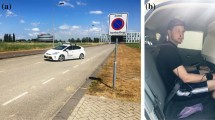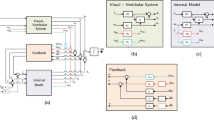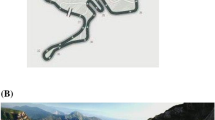Abstract
The enjoyment and usage of highly automated vehicles might be reduced by motion sickness. This study addresses the influencing factors of dynamic stimulation, visual perception and individual motion sickness susceptibility in a real car environment. Based on the sensory rearrangement theory the stimulation of the vestibular organs effects motion sickness. The dynamic stimulation seen as vehicle acceleration is evaluated by the Motion Sickness Dose Value (MSDV). 30 participants experienced a stop-and-go driving scenario while looking outside and on a display inside the car. Participants were preselected to represent a group susceptible to motion sickness. A driving profile with alternating low and high stimulating characteristics was used. Three symptoms of motion sickness were verbally rated on a scale from zero to ten at one minute intervals. The symptom ratings show a significant increase for the situation of video watching on the display in this purely longitudinal stimulation. Dynamic stimulation, visual perception and individual susceptibility act as equally important factors for modeling motion sickness intensity. To estimate the intensity of motion sickness the extension of the MSDV by inclusion of visual perception and individual susceptibility is strongly recommended.
Zusammenfassung
Das Auftreten von Kinetose kann die Gebrauchsfreundlichkeit sowie Nutzungsnachfrage von automatisch fahrenden Fahrzeugen vermindern. Die dargestellte Untersuchung betrachtet die Einflussfaktoren dynamische Stimulation, visuelle Wahrnehmung und individuelle Kinetoseempfindlichkeit in einem realen Fahrversuch. Die dynamische Stimulation führt, ausgehend von der sensorischen Umorganisationstheorie, zu einer Anregung des vestibulären Systems und zum Auftreten von Kinetose. Eine Bewertung der dynamischen Stimulation basierend auf den Fahrzeugbeschleunigungen ermöglicht die Motion Sickness Dose Value (MSDV). Für die Untersuchung wird ein Fahrprofil bestehend aus alternierende Phasen mit verringerter und erhöhter Dynamik genutzt. 30 Personen erleben eine kontrollierte Stop-and-Go-Situation, während sie entweder auf ein vorausfahrendes Fahrzeug oder ein Video auf einem Monitor schauen. Die Teilnehmenden repräsentieren Personen mit erhöhter Kinetoseempfindlichkeit. Die Erfassung von Kinetose erfolgt durch eine minütliche verbale Abfrage von drei Einzelsymptomen auf Skalen von 0 bis 10. Die Symptombewertungen zeigen einen signifikanten Anstieg während der Videobetrachtung in dieser ausschließlich longitudinalen Fahrzeuganregung. Eine modelbasierte Analyse der Symptombewertungen zeigt, dass die dynamische Stimulation, die visuelle Wahrnehmung und die individuelle Kinetoseempfindlichkeit gleichermaßen bedeutsam sind. Für eine fundierte Abschätzung der Kinetoseintensität einer realen Situation wird empfohlen, den Kennwert der MSDV um Indikatoren zur Beschreibung der verfügbaren visuellen Informationen sowie der individuellen Empfindlichkeit zu ergänzen.






Similar content being viewed by others
References
Griffin M (2001) Motion Sickness. In: Encyclopedia of Vibration. Academic Press,
Reason JT, Brand JJ (1975) Motion Sickness. Academic Press,
Winner H, Hakuli S, Lotz F, Singer C (2015) Handbuch Fahrerassistenzsysteme: Grundlagen, Komponenten und Systeme für aktive Sicherheit und. Komfort, vol 3. Springer Vieweg, überarbeitete und ergänzte Auflage Aufl.). Wiesbaden
Diels C, Bos J (2016) Self-driving carsickness. Appl Ergon 53:374–382
ISO 2631-1:1997 (1997) Mechanical vibration and shock—Evaluation of human exposure to whole-body vibration. International Organization for Standardization
Turner M (1994) Driven to sickness? The effect of individual driving style on motion sickness occurrence. In: Proceedings of the. Informal Group Meeting on Human Response to Vibration, UK, pp 19–21
Griffin M, Newman M (2004) An experimental study of low-frequency motion in cars. Proc Inst Mech Eng Part D: J Automob Eng 218:1231–1238
Karjanto J et al (2018) Development of On-Road Automated Vehicle Simulator for Motion Sickness Studies. International Journal of Driving Science 1(1):2,1–12. https://doi.org/10.5334/ijds.8
Donohew BE, Griffin M (2004) Motion sickness: effect of the frequency of lateral oscillation. Aviat Space Environ Med 75:649–656
Bartels A, Karrenberg S, Weiser A, others (2011) Hochautomatisches Fahren auf der Autobahn. In: Automobiltechnische Zeitschrift
Kerner BS (2017) Introduction—The Reason for. Paradigm, Shift in Transportation Science. In: Breakdown in Traffic Networks. Springer, pp 1–71
Kyriakidis M, Happee R, de Winter JC (2015) Public opinion on automated driving: Results of an international questionnaire among 5000 respondents. Transportation research part F. Traffic Psychol Behav 32:127–140
Griffin M, Newman M (2004) Visual field effects on motion sickness in cars. Aviat Space Environ Med 75:739–748
Diels C, Bos J, Hottelart K, Reilhac P (2016) Motion Sickness in Automated Vehicles: The Elephant in the Room. In: Road Vehicle. Automation, vol 3. Springer, , pp 121–129
Kuiper OX, Bos J, Diels C (2018) Looking forward: In-vehicle auxiliary display positioning affects carsickness. Appl Ergon 68:169–175
Wada T, Yoshida K (2016) Effect of passengers’ active head tilt and opening/closure of eyes on motion sickness in lateral acceleration environment of cars. Ergonomics 59:1050–1059
Schmidt EA, Kuiper OX, Wolter S et al (2020) An international survey on the incidence and modulating factors of carsickness. Transportation Res Part F: Traffic Psychol Behav 71:76–87
Dobie TG (2019) Motion Sickness: A Motion Adaptation Syndrome. Springer,
Golding J (2006) Predicting individual differences in motion sickness susceptibility by questionnaire. Pers Individ Dif 41:237–248
World Medical Association (2001) World Medical Association Declaration of Helsinki. Ethical principles for medical research involving human subjects. Bull World Health Organ 79:373–374
Kato K, Kitazaki S (2006) A Study of Carsickness of Rear-seat Passengers due to Acceleration and Deceleration when Watching an In-vehicle Display. Rev Automot Eng 27:465
Vogel H, Kohlhaas R, von Baumgarten R (1982) Dependence of motion sickness in automobiles on the direction of linear acceleration. Europ J Appl Physiol 48:399–405
Braess H‑H, Seiffert U (2013) Handbuch Kraftfahrzeugtechnik. Vieweg,
SAE International (2014) Taxonomy and definitions for terms related to on-road motor vehicle automated driving systems. Int Stand J3016
Lackner JR (2014) Motion sickness: more than nausea and vomiting. Exp Brain Res 232:2493–2510
Vollrath M (2015) Statistische Methoden. In: Automobilergonomie. Springer, , pp 663–684
Irmak T, Pool DM, Happee R (2020) Objective and subjective responses to motion sickness: the group and the individual. Exp Brain Res. https://doi.org/10.1007/s00221-020-05986-6
Yusof NM (2019) Comfort in autonomous car: mitigating motion sickness by enhancing situation awareness through haptic displays
Isu N, Hasegawa T, Takeuchi I, Morimoto A (2014) Quantitative analysis of time-course development of motion sickness caused by in-vehicle video watching. Displays 35:90–97
Keshavarz B, Hecht H (2011) Validating an efficient method to quantify motion sickness. Hum Factors 53:415–426
Bos J, MacKinnon SN, Patterson A (2005) Motion sickness symptoms in a ship motion simulator: effects of inside, outside, and no view. Aviat Space Environ Med 76:1111–1118
Brietzke A, Klamroth A, Dettmann A, Bullinger AC (2017) Motion sickness in cars: Influencing human factors as an outlook to highly automated driving [Poster]. Varieties of interaction: from User Experience to Neuroergonomics, Postersession, Human Factors and Ergonomics Society Europe Chapter 2017 Annual Conference 28 Sept 2017 bis 30.09.2017, Rome. https://www.hfes-europe.org/wp-content/uploads/2017/10/Brietzke2017poster.pdf. Accessed 20 Apr 2019
Probst T, Krafczyk S, Büchele W, Brandt T (1982) Visual prevention from motion sickness in cars. Arch Psychiatr Nervenkr 231:409–421
Atsumi B, Tokunaga H, Kanamori H et al (2002) Evaluation of vehicle motion sickness due to vehicle vibration. Jsae Rev 23:341–346
Marco CA, Marco AP, Plewa MC et al (2006) The Verbal Numeric Pain Scale: Effects of Patient Education on Self-reports of Pain. Acad Emerg Med 13:853–859
Schneider E, Villgrattner T, Vockeroth J et al (2009) EyeSeeCam: an eye movement-driven head camera for the examination of natural visual exploration. Ann N Y Acad Sci 1164:461–467
Leonhart R (2009) Lehrbuch Statistik: Einstieg und Vertiefung. Huber, Bern
Cohen J (1992) A power primer. Psychol Bull 112:155
Reason J, Graybiel A (1970) Changes in subjective estimates of well-being during the onset and remission of motion sickness symptomatology in the slow rotation room. Aerosp Med 41(166):171
Wada T, Konno H, Fujisawa S, Doi S (2012) Can passengers’ active head tilt decrease the severity of carsickness? Effect of head tilt on severity of motion sickness in a lateral acceleration environment. Hum Factors 54:226–234
Kato K, Kitazaki S (2006) A study for understanding carsickness based on the sensory conflict theory
Morimoto A, Isu N, Ioku D, Asano H, Kawai A, Masui F (2008) Effects of reading books and watching movies on inducement of car sickness, Proceedings of FISITA 2008 World Automotive Congress (CD-ROM), F2008-02-24
Funding
The study was financed by Volkswagen AG.
Author information
Authors and Affiliations
Corresponding author
Ethics declarations
Conflict of interest
A.B. and R.P.X. are employed by Volkswagen AG. A.B.-H. and A.D. declare no competing conflicts of interest. The study was conducted and financed by Volkswagen AG.
Rights and permissions
About this article
Cite this article
Brietzke, A., Pham Xuan, R., Dettmann, A. et al. Influence of dynamic stimulation, visual perception and individual susceptibility to car sickness during controlled stop-and-go driving. Forsch Ingenieurwes 85, 517–526 (2021). https://doi.org/10.1007/s10010-021-00441-6
Received:
Revised:
Accepted:
Published:
Issue Date:
DOI: https://doi.org/10.1007/s10010-021-00441-6




